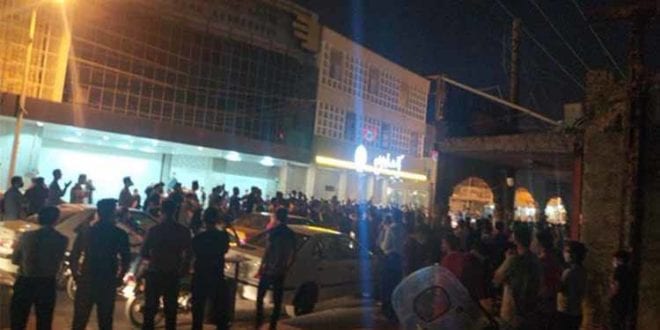RFL/RE – A provocative street protest in southwestern Iran last week that was critical of the Islamic establishment has many predicting more demonstrations are coming amid the country’s faltering economy and anger over the handling of the coronavirus pandemic.
People in the city of Behbahan chanted anti-government slogans including “Mullah’s regime, we don’t want it!” before the July 16 protest was hastily broken up by police using tear gas.
General dissatisfaction in society has been exacerbated by the desperate state of the Iranian economy — due to crippling U.S. sanctions and mismanagement — as well as a renewed spike in COVID-19 infections and deaths that has led to a return to lockdown measures, which have contributed to even higher unemployment rates and increased poverty.
“The risk of widespread protests in Iran is likely higher now than at any point in the last six months,” Henry Rome, an Iran analyst at the Eurasia Group in Washington, told RFE/RL.
In Tehran, sociologist Saeed Madani said the pandemic has worsened the situation of “the poor and even some in the middle class” who now face more financial problems that create pressure difficult to tolerate.
“It is quite evident and predictable that this extent of pressure will result in protests among low-income families,” Madani said in a recent interview with the BBC’s Persian Service, adding that the country has been experiencing a trend toward increased protests in recent years.
All-Time Lows
Under pressure from U.S. sanctions that have slashed oil exports, the country’s primary source of revenue, Iran is suffering from high inflation, some 40 percent in 2019, and a national currency that has plunged to all-time lows against the dollar in recent days.
The International Monetary Fund (IMF) predicts that the Iranian economy will shrink by 6 percent this year. An April report by the country’s Parliamentary Research think tank said that as many as 6.43 million Iranians could lose their jobs due to the coronavirus that has killed at least 15,000 people and infected more than 280,000.
A deputy health minister said in April that COVID-19 fatalities are higher among the poor due to their limited access to sanitary goods and health-care services.
Due to skyrocketing prices and the rial’s free fall, the purchasing power of Iranians has declined rapidly and many in the country of more than 80 million people have had their savings wiped out.
“Today I worked for as much as ‘two dollars’ from the morning till the evening,” a journalist with the semiofficial ISNA news agency wrote on Twitter this week, highlighting the sharp drop in the value of the rial.
Amid the declining economy, officials have also warned recently that the situation could trigger unrest and street riots.
The latest warning came over the weekend by lawmaker Hosseinali Shahriari, who said that people are being pushed to the edge due to rising poverty and unemployment.
“If the government doesn’t take action, people will one day take to the streets due to poverty, hunger, and pressure and kick us out of the parliament and kick officials out of the government,” said Shahriari, who represents Zahedan, the capital of Sistan-Baluchistan, one of Iran’s poorest provinces, in parliament.
“It won’t take long,” he said in his July 21 speech, accusing Iranian leaders of “having closed their eyes.”

Earlier in the month, on July 8, Health Minister Saeed Namaki warned that economic pressure could lead to an uprising in society while urging experts to find ways to prevent Iranians from taking to the streets due to “hunger and poverty.”
In late June, prominent cleric Ayatollah Mohammad Musavi Khoeniha warned that the situation in the country was “unsustainable.”
“Rising inflation along with the declining income of large segments [of society] has created backbreaking problems for the people…and worried them about their own future and that of their children,” Khoeniha said in a letter addressed to Supreme Leader Ayatollah Ali Khamenei.
Year Of Crisis
In April, 50 economists warned in a letter to President Hassan Rohani that the coronavirus pandemic raises the risk of unrest in the second half of the current Iranian calendar year that started on March 21, while warning that the next Iranian year will be a year of crisis.
They also suggested in the letter, published widely in domestic media, that the coronavirus outbreak was likely to exacerbate inflation, unemployment, and poverty in the country while also worsening the government’s budget deficit.
Iran was rocked by violent protests in November sparked by a sudden hike in the price of gasoline. The protests, which quickly turned political with many chanting against Iranian leaders, were met by a harsh crackdown that left at least 304 dead, according to Amnesty International.
The Islamic establishment appears determined to prevent a reemergence of the unrest, which also resulted in death sentences for three protesters that were suspended over the weekend following widespread outrage and a massive social-media campaign.
“The security forces will almost certainly respond swiftly to the spread of [any new] protests,” said analyst Rome.
“While some in the U.S. and the region will view protests as an indication of a regime on its last legs, there is little reason to doubt Khamenei’s commitment to maintaining control or the [Islamic Revolutionary Guards Corps’] ability to carry out its mandate,” Rome added.
Following the protest in Behbahan, the city’s police chief, Mohammad Azizi, vowed to deal “decisively” with any further protests.
Meanwhile, the IRGC announced the arrests of “agitators” and individuals “connected to anti-revolutionary groups” in the northeastern cities of Mashhad and Shiraz.
- Golnaz EsfandiariGolnaz Esfandiari is a senior correspondent with RFE/RL.
 Shabtabnews In this dark night, I have lost my way – Arise from a corner, oh you the star of guidance.
Shabtabnews In this dark night, I have lost my way – Arise from a corner, oh you the star of guidance.



